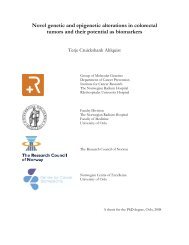Preface - Ous-research.no
Preface - Ous-research.no
Preface - Ous-research.no
You also want an ePaper? Increase the reach of your titles
YUMPU automatically turns print PDFs into web optimized ePapers that Google loves.
Cell Transplantation<br />
Background<br />
Type 1 diabetes is an autoimmune disease with destruction<br />
of insulin producing β cells, leading to dysregulated glucose<br />
homeostasis. Despite effective insulin therapy, allowing<br />
these patients to survive, imperfect blood sugar control may<br />
result in micro-vascular complications. These complications<br />
can to some extent, be prevented by maintaining near<strong>no</strong>rmal<br />
glucose control by multiple daily insulin injections<br />
or insulin-pump therapy. However, stable metabolic control<br />
is difficult to achieve in some patients despite the use of<br />
modern insulin analogues and delivery systems, resulting in<br />
life threatening episodes of insulin-induced hypoglycemia.<br />
Transplantation of whole organ pancreas is an optional<br />
treatment for type 1 diabetes. A major drawback of the<br />
procedure is the complexity of the surgery and postoperative<br />
complications caused especially by the exocrine<br />
pancreatic tissue. On the opposite, islet cell transplantation<br />
is a simple and gentle procedure with few complications.<br />
It is performed in local anesthesia. A catheter is inserted<br />
trans-hepatically into the main stem of the portal vein.<br />
Purified islets flow by gravity from the infusion bag through<br />
the catheter and are dispersed in the sinusoids throughout<br />
the liver (Fig. 1). Subsequently, a neo-angiogenesis occurs<br />
(engraftment) and the islets begin to produce and release<br />
insulin within two weeks after the transplantation. The patient<br />
remains awake during the entire procedure which lasts<br />
for less than one hour.<br />
Several reports have shown that up to 80% of the patients<br />
transplanted are off insulin one year after islet transplantation,<br />
but only a few remain free from insulin requirement<br />
long term. However, the majority of patients have significant<br />
C-peptide production five years after the transplantation<br />
and thus, many patients who previously were suffering<br />
from life threatening hypoglycemia exhibit well-regulated<br />
metabolic control and improved quality of life.<br />
Multiple deleterious events affect the amount and quality of<br />
islets from the time of ICU-treatment of the do<strong>no</strong>r, through<br />
the processes of brain death, organ retrieval, islet isolation,<br />
infusion and engraftment. Following successful engraftment<br />
islets are influenced by allo- and autoimmunity and<br />
Figure 1. Aspects of islet cell transplantation.<br />
Figure 2.<br />
Schematic presentation of loss of islets from the time of organ<br />
retrieval to revascularization in the recipient.<br />
1. Loss of islets during brain death and organ harvest. 2. Loss of<br />
islets during islet isolation. 3. Loss of islets during pre-transplant<br />
culture. 4. Loss of islets during the islet transplant procedure 5.<br />
Loss of islets during post-transplant period prior to revascularization.<br />
Green area represents insulin-independence, red area<br />
insulin dependence for the patient.<br />
32
















